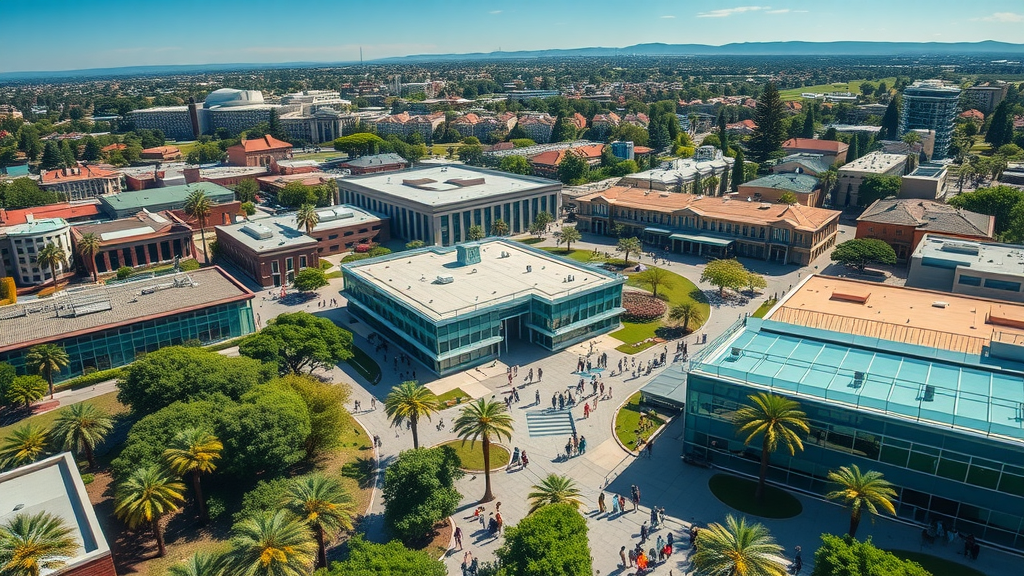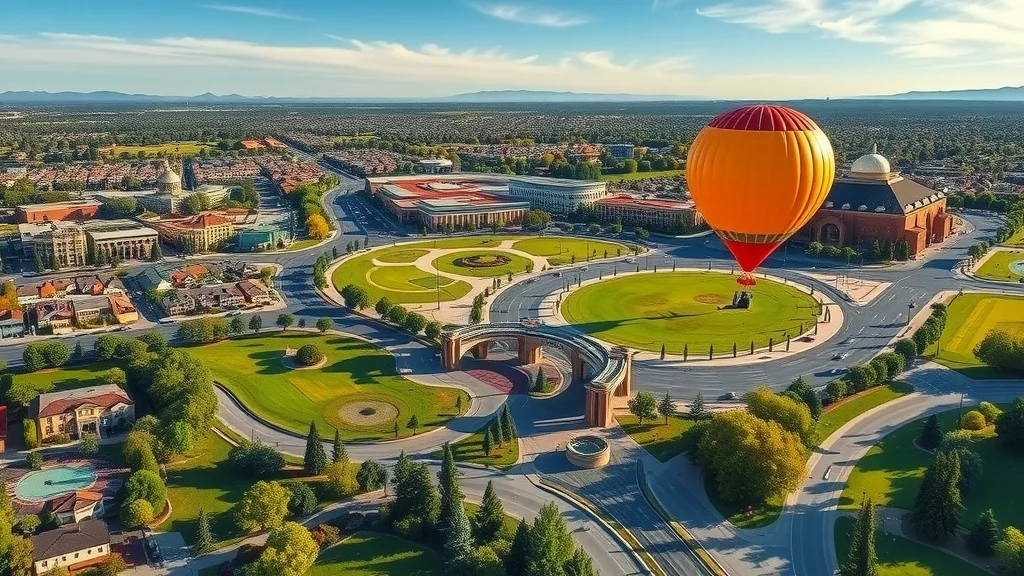Did you know that UC Irvine and much of the city of Irvine owe their very existence to a forward-thinking woman who helped shape the master plan for Southern California’s future? UC Irvine's history is packed with surprising facts: it’s one of only a handful of American universities established in the 1960s that quickly became a world-class research institution. From Nobel Prize-winning faculty to game-changing partnerships, the story of UC Irvine is about more than just a campus; it’s the tale of visionaries, communities, and the power of collaboration. In this article, you’ll journey from the untold origins of UC Irvine through its bold milestones, learn about the people who made it possible, and discover how its legacy continues to change lives today.
Surprising Origins: Key Facts Shaping UC Irvine History
When diving into UC Irvine's history, you’ll find a legacy much more unconventional than most universities. Established as part of a strategic master plan for the University of California system, UCI’s very foundation reflects a unique partnership between the Irvine Company, the city of Irvine, and the aspirations of visionary leaders like Joan Irvine Smith. Unlike many institutions, UCI’s creation wasn’t a gradual expansion but a bold jump-start, built from generous land donations and driven by an urgent need for higher education in burgeoning Orange County. Within decades, UCI exploded onto the academic scene, gaining prestige for its social science research, pioneering sustainability efforts, and robust community engagement. The roots of UC Irvine's history reveal a place that’s continually innovating and smashing expectations, not content to follow but to boldly lead.
The first classes began in makeshift trailers, and the campus expanded rapidly as a result of careful planning and community support. Today, with award-winning faculties, a top-ranked graduate school, and a legacy of Nobel Prize recipients, UCI sits among the best institutions in the United States, impacting the city of Irvine and beyond. Its unique beginnings, set against the rolling hills of the old Irvine Ranch, set UCI apart as both a catalyst for local growth and a beacon of academic excellence.

UC Irvine was founded in 1965 on land originally owned by the Irvine Ranch and donated by Joan Irvine Smith.
The campus was designed by world-renowned architect William Pereira as part of the city’s “master plan.”
Today, UCI is recognized for its leading research in social sciences and has produced multiple faculty members with a Nobel Prize.
UCI’s park-like center, Aldrich Park, spans 19 acres and acts as a central gathering point for students and faculty.
UCI helped transform Orange County from an agricultural area into a thriving center for innovation and education.
Its innovative East Asian studies and interdisciplinary programs are ranked among the top in the country.
What You'll Learn About UC Irvine History
The story of Joan Irvine Smith’s legacy and her pivotal role in founding UC Irvine.
The place of UC Irvine within the broader University of California system.
How collaboration with the city of Irvine catalyzed community growth.
The remarkable evolution of UCI’s social sciences and research breakthroughs.
Spotlights on UC Irvine’s notable alumni and their achievements worldwide.
Joan Irvine Smith: The Visionary Behind UC Irvine History
Early Life and Influences of Joan Irvine Smith
The roots of UC Irvine's history can be traced directly to the personal vision of Joan Irvine Smith, a member of the legendary Irvine family whose land shaped much of Southern California. Raised within the legacy of the Irvine Ranch a sprawling property stretching across Orange County, Joan was deeply influenced by her grandfather, James Irvine. Her upbringing surrounded by agriculture, community-mindedness, and stewardship of the land inspired her foresight and philanthropy. Her commitment to education and innovation is reflected in her later advocacy for a new University of California campus, ushering in an era of transformation not just for her family but the region as a whole.
Despite facing skepticism in a male-dominated industry, Joan’s unwavering resolve to dedicate hundreds of acres to higher education ultimately helped birth both the city of Irvine and UC Irvine. Her legacy lives in every graduate class, every research breakthrough, and every faculty member inspired to make a difference on and beyond the campus. Her ability to see the future, where the old ranchland could foster knowledge, diversity, and community, continues as a central pillar in UC Irvine history.

Crucial Land Donations and Advocacy for the University of California
Joan Irvine Smith’s donation of over 1,000 acres to launch UC Irvine was a monumental act of generosity and courage. Amidst pressure to commercialize the land, she believed that building a university would yield greater returns by planting the seeds of knowledge. Through her advocacy, the University of California system saw value in establishing a campus in the rapidly growing Orange County region.
This act was more than a business transaction; it was a statement of intent, blending public good with smart planning. Joan personally lobbied UC trustees and city officials, ensuring the campus would anchor the city’s ambitious master plan. She also oversaw the initial planning phases, working with both the Irvine Company and visionary architect William Pereira to set the university in harmony with its environment. Her advocacy and determination built the foundations of what would soon become one of the fastest-growing, most respected universities in the United States.
“Without Joan Irvine Smith’s vision and perseverance, UC Irvine might never have become a reality.” — UC Historian
The Birth of UC Irvine: A University of California Milestone
Selecting the Site: City of Irvine and the University’s Expansion
Choosing the right location was pivotal to the dream of UC Irvine. With much of the Irvine Ranch available, Joan Irvine Smith, together with University of California leaders and the city’s forward-thinking planners, pinpointed a hub where education could meet innovation and community growth. The area surrounding the burgeoning city of Irvine was ideal—close to major transport lines, sheltered by the picturesque hills of San Joaquin and Turtle Rock, and central to Orange County’s new master plan.
By integrating the university into the heart of the new city of Irvine, the campus would not only serve students but also act as a catalyst for the surrounding region, creating jobs, stimulating cultural exchange, and fostering long-term sustainability. Early plans featured extensive green spaces, a walking-friendly campus design, and iconic elements like Aldrich Park as its “academic heart.” This bold vision attracted not just students but faculty members, researchers, and innovators from across the globe.

Groundbreaking Events in UC Irvine History
The official groundbreaking of UC Irvine in 1964 set off a cascade of milestones that would, in turn, shape the regional and academic landscape forever. From the opening of Aldrich Hall to the birth of the School of Social Sciences, each moment marked new growth—rapidly evolving from bare foundations into a bustling center of academic activity. The partnership between the University of California Board, Irvine Company, and city planners provided a master blueprint for integrating education into community development.
By 1965, the first classes welcomed students in temporary structures as construction crews raced to finish key buildings. These monumental early days laid the groundwork for a university that would become synonymous with innovation, research, and community collaboration, eventually earning UCI recognition as a top ranked UC on national and global scales.
Key Dates in UC Irvine History |
|
Year |
Milestone |
|---|---|
1960 |
Site selection confirmed; collaboration with city officials and planners begins |
1964 |
Official groundbreaking ceremony; William Pereira unveils campus design |
1965 |
UC Irvine opens with over 1,500 students; Aldrich Hall becomes administrative hub |
1970 |
Establishment of the School of Social Sciences and major research centers |
1971 |
Incorporation of the city of Irvine; continued joint infrastructure projects |
2004 |
UC Irvine celebrates its first Nobel Prize in chemistry (faculty member Irwin Rose) |
City of Irvine and Its Enduring Partnership with UC Irvine
Shaping the Community: How the University Influenced the City of Irvine's Growth
The collaboration between UC Irvine and the city of Irvine stands as a model for university-city synergy across the United States. From the earliest planning meetings, both partners recognized that shared growth would benefit students, local businesses, and the wider community. The master plan linked campus infrastructure like roads, utilities, and public spaces with broader city planning, creating a seamless blend of academic and civic life. As UCI expanded, it brought waves of students, faculty members, and researchers, fostering new neighborhoods, cultural centers, and robust public services.
This relationship transformed the city from agricultural fields into a thriving, diverse urban community anchored by world-class education. UC Irvine became a driver for economic growth, with alumni founding companies, social science departments pioneering research, and strong public service programs connecting students directly to local needs. Together, the city of Irvine and UC Irvine continue to shape each other’s stories—an ongoing partnership that’s much more than just sharing an address.
Joint city-university infrastructure projects, including roads and greenways
Community wellness and health outreach programs led by faculty and students
Collaborative public art and sustainability initiatives, such as urban forests
Shared use of Aldrich Park and local parks for events, recreation, and cultural festivals
Internship, mentorship, and job-training programs linking city residents with UC Irvine faculty and alumni

Evolution of Social Sciences at UC Irvine
Founding and Growth of the Social Science and Social Sciences Departments
The School of Social Sciences at UC Irvine has played a remarkable role in advancing the university’s profile and impact. Founded in the early 1970s, it was part of the university’s forward-thinking master plan and quickly established itself as one of the most dynamic divisions on campus. The school attracted a rich academic community, including pioneering faculty like Murray Krieger, whose work set new standards in literary theory and critical studies.
Over time, UCI’s social science and social sciences departments introduced interdisciplinary programs that brought together political science, anthropology, economics, and sociology, turning the university into a leader in policy analysis and community research. Strong graduate degree offerings brought ambitious students from around the world, while innovative teaching styles made UCI’s social sciences a model for other University of California campuses.

Influential Social Science Research at UC Irvine
From its earliest years, UC Irvine’s social sciences have produced research that reverberates across the globe. Notable achievements include breakthroughs in population studies and political science, the founding of the Institute for Mathematical Behavioral Sciences, and recognized work in social networks and technology’s impact on communities. UCI’s commitment to interdisciplinary scholarship fosters innovation, attracting distinguished faculty members and consistently earning top-ranked UCI honors among American universities.
Faculty within the social science departments frequently collaborate with external organizations, governments, and nonprofits, delivering data-driven solutions to real-world challenges. This approach positioned UCI as not only an academic powerhouse but a center for social change. Today, UCI’s social sciences alumni are leaders in research, policy, and education, continuing to raise the university’s profile and fulfill the founding vision.
Founding of the Institute for Mathematical Behavioral Sciences
Key research breakthroughs in migration, voting behavior, and social networks
Internationally ranked programs in political science and economics
Establishment of the Center for Global Peace and Conflict Studies
Interdisciplinary research centers that shape national and international policy debates
UC Irvine History Through the Decades
1960s–1980s: From Inception to Academic Excellence
The first two decades were a period of exceptional growth for UC Irvine. Starting with just a handful of buildings and a few thousand students, the university focused heavily on building its academic credentials. By the late 1970s, UCI had already become one of the most respected public campuses in the University of California system. Its focus on social science and scientific research quickly drew notice, as faculty won major awards and programs expanded.
During this period, the university’s tradition of innovation took root with the launch of interdisciplinary programs and a uniquely open, collaborative culture. New residence halls in San Joaquin and Aldrich Park transformed student life, while athletics teams brought home national championships, and faculty members like Murray Krieger elevated UCI’s academic profile. The university’s careful planning and emphasis on community engagement helped set the standard for what a campus could accomplish.

1990s–Present: Innovation, Diversity, and City of Irvine Expansion
The past three decades have been characterized by explosive innovation at UCI. New graduate schools, industry partnerships, and state-of-the-art research facilities have kept the university at the cutting edge. The city’s population boomed alongside the campus, turning Irvine into a hub for global business and cultural diversity. Top-ranked UCI programs in medical research, sustainability, and technology drew new students and faculty from around the globe.
UCI’s athletic programs also flourished, bringing in more NCAA Division national championships and securing the campus’s place as both an academic and athletic powerhouse. Campus events like the annual Aldrich Park festival and new interdisciplinary programs fostered a culture of belonging. Today, UCI is recognized for its deep commitment to equity, global leadership, and community service—proof that its founding vision remains alive in every corner of campus.
Video timeline showcasing UC Irvine milestones and city partnership highlights
UC Irvine’s Notable Alumni and Their Impact
Michael Chabon – Pulitzer Prize-winning author and influential voice in contemporary literature
Masi Oka – Computer scientist and Emmy-nominated actor known for Heroes
Amanda Beard – Olympic gold medalist and champion swimmer
Greg Louganis – Four-time Olympic gold medalist in diving
David Benioff – Co-creator of HBO’s Game of Thrones (M.F.A. in creative writing)
Ana Rosa – Renowned reporter and social advocate
Faculty Nobel Laureates – Including Irwin Rose (Chemistry, 2004)

Frequently Asked Questions About UC Irvine History
What is the history of UC Irvine?
UC Irvine was founded in the 1960s as part of the University of California system, largely due to Joan Irvine Smith’s significant land donation and advocacy. The university has grown into a leading research institution, shaping the city of Irvine and the broader community.
What famous person went to UC Irvine?
Numerous notable individuals have graduated from UC Irvine, including Pulitzer Prize winner Michael Chabon, computer scientist Masi Oka, and Olympic gold medalist Amanda Beard.
What is UC Irvine famous for?
UC Irvine is renowned for its world-class programs in the social sciences, medical research, sustainability innovation, and inclusive campus culture.
Is UC Irvine in the Ivy League?
No, UC Irvine is not part of the Ivy League. Rather, it is a prestigious member of the University of California system, recognized for excellence in research, education, and community engagement.
Key Takeaways from UC Irvine History
Joan Irvine Smith’s vision was instrumental in UC Irvine’s founding and ongoing influence.
The campus-city partnership spurred Irvine’s transformation into a vibrant, innovative community.
UC Irvine’s success within the University of California system set a new standard for public education.
Major innovations in social science and interdisciplinary learning have shaped both the local landscape and global conversations.

Conclusion: Continuing the Legacy of UC Irvine History
UC Irvine’s story is far from over. Its bold legacy as a place of vision, community, and excellence continues to guide students, faculty, and the city of Irvine into an inspiring future.
"UC Irvine's legacy is built not just on bricks and mortar, but on the vision and commitment of the people who dared to dream big." — Campus historian
The Daro Digital Team Can Help You Become an Authority Like UC Irvine
The Daro Digital Team hopes this article has been interesting and valuable to you. Do you have any questions, or would you like us to help your company with Local Marketing and becoming a Trusted Topical Authority in your industry? Send us an email: info@darodigitalmedia.com or schedule a call with us at https://talkwithrob.com.
 Add Row
Add Row  Add
Add 



